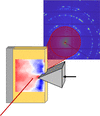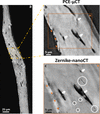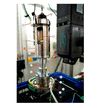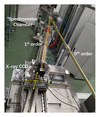issue contents
January 2024 issue

Cover illustration: A collection of mouse tissue biopsy samples displaying the capabilities of the High-Throughput Tomography (HiTT) setup on EMBL beamline P14 at PETRA III (see Albers, Nikolova, Svetlove, Darif, Lawson, Schneider, Schwab, Bourenkov and Duke, pages 186–194).
facility information
feature articles
Open  access
access
 access
accessThe African Light Source project towards a light source for the African continent is described.
research papers
Open  access
access
 access
accessAn active piezoelectric plane X-ray focusing mirror with a linearly changing thickness is presented. Focusing performances of the prototype are measured and a single-micrometre focusing result is achieved.
Open  access
access
 access
accessThe development of a time-resolved X-ray diffraction technique using synchrotron radiation in pulsed mode to estimate the stress and the mechanical work during an ultrasonic fatigue test is presented.
Open  access
access
 access
accessAn approach to reliably extract the desired intensities and filter out multiple-beam X-ray diffraction, which often causes interference for high X-ray energies and for large unit cells, is presented. Here, a universal concept of data acquisition and post-processing for resonant X-ray diffraction experiments is described, including the measurement of the energy-dependent intensity at several azimuth angles and subsequently only considering the unaffected data points.
Open  access
access
 access
accessA method to acquire X-ray scattered signals at high frequency while the detector is moving is proposed. The algorithm provided can break through the pixel size limitation, and the resolution is improved by almost ten times compared with that of a single pixel.
Open  access
access
 access
accessScanning nanodiffraction mapping was used to map stresses, plastic deformation and cracking of hard coatings during nanoindentation.
Open  access
access
 access
accessX-ray illumination induces surface charging and gives rise to substantially enhanced piezoresponse in a relaxor ferroelectric captured by X-ray photon correlation spectroscopy.
Open  access
access
 access
accessThe technical performance of ultra-small-angle X-ray photon correlation spectroscopy with the ESRF Extremely Brilliant Source is presented. The brighter X-ray source together with advanced pixel array detectors enable investigations of faster dynamics in relatively dilute suspensions by this method.
Open  access
access
 access
accessA plug-flow fixed-bed cell for synchrotron powder X-ray diffraction (PXRD) and X-ray absorption fine-structure (XAFS) idoneous for the study of heterogeneous catalysts at high temperature, pressure and under gas flow is designed, constructed and demonstrated. The operating conditions up to 1000°C and 50 bar are ensured by a set of mass flow controllers, pressure regulators and two infra-red lamps that constitute a robust and ultra-fast heating and cooling method.
Open  access
access
 access
accesstomoCAM is an open-source implementation of model-based iterative reconstructions that reformulates the iterative tomographic reconstruction problem to leverage the faster time complexity of non-uniform fast Fourier transforms. Moreover, it harnesses the computational capabilities of modern GPUs, leading to significant performance gains compared with currently available publicly accessible tools. tomoCAM is accessible via Python and is compatible with NumPy, facilitating its incorporation into pre-existing workflows at synchrotron light sources.
Open  access
access
 access
accessThe similarity score is a useful metric for screening electron density maps from phase-retrieval calculations in X-ray diffraction imaging. The characteristics of the score have been studied in reciprocal space and are described here.
Open  access
access
 access
accessA protocol to steer phase-retrieval calculations to realistic density maps is proposed.
Open  access
access
 access
accessAn innovative adaptive scan technique for high-resolution X-ray ptychography is introduced that offers automated guidance for the scan trajectory along an object's boundary, selectively acquiring measurements relevant to the region of interest.
Open  access
access
 access
accessA deep-learning processing approach is proposed to assess in three dimensions the micro- and nano-porosity in bone imaged by Zernike nano-computed tomography.
Open  access
access
 access
accessHeitt Mjolnir, a heated miniature triaxial apparatus for 4D synchrotron microtomography, is described. This new device combines the capacities of a deformation rig and a thermal reactor with large sample volumes and is suitable for a large range of geo-energy applications.
beamlines
Open  access
access
 access
accessThe main characteristics of the beamline SIRIUS at Synchrotron SOLEIL relevant for soft matter science are presented, as well as recent developments of new sample environments and of X-ray focusing with compound refractive lenses.
Open  access
access
 access
accessThe design and first-round commissioning results of the SASE beamline at the Shanghai Soft X-ray FEL facility are presented.
Open  access
access
 access
accessHigh-throughput tomography, a propagation-based phase-contrast X-ray imaging technique that can visualize 1 mm3 biological samples of various types at high resolution, is presented. 3D reconstructions of the imaged volumes are calculated automatically once data collection is complete. The entire process from pressing start on data collection to viewing the final data takes less than three minutes. This speed, in combination with the use of an automated sample changer to exchange the samples, truly enables high-throughput X-ray imaging for the first time.
Open  access
access
 access
accessA microscope hosted at Taiwan Photon Source beamline 27A2 that packs the functions of photoemission electron microscopy and angle-resolved photoemission spectroscopy into one single instrument is presented.
computer programs
Open  access
access
 access
accessA new software, Beagle, has been developed to analyze NEXAFS spectroscopy at PAL. It calculates molecular orientation for high-throughput experiments, handling more than 100 samples per day.

 journal menu
journal menu








































